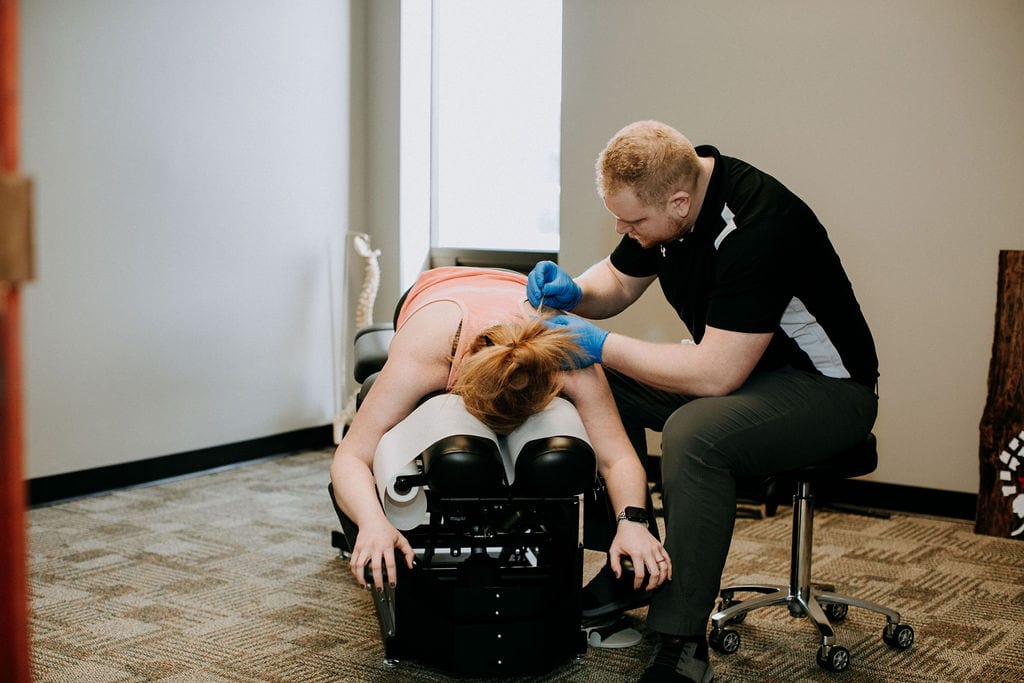Dry Needling in Kearney
Elite Dry Needling
Dry needling is a manual therapy technique that involves inserting a thin needle into the body to heal dysfunctional muscle tissue.
Dry needling can help decrease muscle oriented pain complaints, improve range of motion, restore mobility, and improve abilities of muscles to contract.
Parts of the body treated with dry needling
Common areas of the body typically treated with dry needling include the neck, low back, shoulder, elbow, hip, knee, and lower leg.
Conditions treated with dry needling
Dry Needling techniques are used to treat musculoskeletal pain and dysfunction associated with, but not limited to:
- Headaches
- Neck Pain
- Jaw Pain
- Back Pain
- Shoulder Pain
- Tennis Elbow
- Golfer’s Elbow
- Nerve Entrapments
- Hip Pain
- Knee Pain
- Shin Splints
- Achilles tendinitis
- Plantar Fasciitis
How does dry needling work?
Trigger Points: Dry needling is typically used to treat myofascial trigger points, or taut bands of dysfunctional muscle tissue, throughout the body with a pistoning motion. Myofascial trigger points can be a primary source of pain, or occur in muscles associated with other conditions. In addition, trigger points are notorious for referring pain to other parts of the body. Thanks to decades of research and observation, we now have well documented charts mapping these patterns out. This is why it’s important for your provider to check the tone and texture of muscles throughout your body.
Electrical Stimulation: In some cases, electrical stimulation may be used with dry needling to treat trigger points. It can be a more comfortable approach compared to pistoning techniques. While the needles clear the trigger points, the electrical stimulation also elicits a natural pain relief response in the area of treatment.
Fascial Tightness: Fascia is a thin connective tissue that surrounds, connects, and holds every organ, blood vessel, bone, nerve, and muscle in place. Much like muscle tightness, Fascial tightness or adhesions can cause dysfunctional movement patterns, inhibit muscle function, and result in pain or injury. By a method called spinning or tenting, dry needling can help stretch the abnormal fascia and restore normal motion.
Tendon Dysfunction: Tendon pecking aims to increase blood flow directly at the point of irritation, which helps promote healing in chronically injured tendons. Pecking is a less used technique, and is best used for larger tendons.
How does dry needling fit into a larger treatment plan?
Dry needling is not designed to be a “cure-all” treatment. Studies show dry needling is more effective when combined with a treatment plan that includes range of motion exercises, muscle strengthening exercises, and other hands-on treatment approaches.
Chiropractic adjustments are great for restricted and stiff joints. A chiropractic adjustment can help increase mobility, promote healing, restore joint biomechanics and improve pain.
How is dry needling different from acupuncture?
Although dry needling and acupuncture both use thin filiform needles, the techniques are actually quite different and serve different purposes in treatment.
Dry needling is rooted in modern Western medicine and incorporates evaluation of pain patterns, postural analysis, movement screening, as well as functional and orthopedic testing to ensure proper application. Patients can expect dry needling to be part of a broader therapeutic approach.
FAQ
In many cases dry needling is covered by most major insurances. Our friendly staff at the Elite Health and Wellness Kearney office will check your benefits to make sure your treatment is covered.
Dry needling can be a part of post-operative care plan, but typically dry needling is contra-indicated immediately following surgery until 8-12 weeks post operatively.
Amount of sessions will vary based on the body area being treated, duration of symptoms, and severity of symptoms present.
Results vary based on duration of symptoms, severity of symptoms, and many times lifestyle choices.
Most common effects on the body as a result of a dry needling session will include needle insertion site soreness, local muscle soreness for 12-18 hours, and occasionally symptoms of nausea or mild lightheadedness.
Dry Needling Specialists

Dr. Sears is driven by his passion to build a stronger, more resilient active community

Dr. Stansbury has a passion for movement. His goal is to help the community move

Matt is a former collegiate football player who has spent nearly his entire professional life
